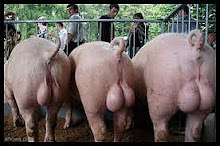I have inspected the pancetta everyday for new spots of moldy fuzz. I removed the spots with a brined-soaked towel but I received some great advice from a reader named Sherry to use red wine vinegar. Applying the red wine vinegar on the mold location prevented any new mold to grow in the same spot. I believe it worked quite well. Thank you.
Here is the pancetta after two weeks.
The colors have darkened while the meat became more firm. The top and bottoms ends, however, firmed up passed the point of being edible. The ends can be cut off though for a flat edge.
Here is the pancetta today, three weeks in since being hung to dry.
The pancetta is clearly ready to come down. The top end is rock hard while the rest of the meat is firm to the touch. The colors have seemed to reach its aging look. The aromas of the spices and herbs are still amazing at this point.
I did a final inspection on the cutting board for creeper molds. The green mold can penetrate and travel through the meat but I did not see any evidence of it. I cut off the ends since they dried hard and to give it a nice, cut end.
The cross section looks pretty amazing. I think it looks like I did an okay job at curing the pork belly. The meat has a good red color to it. It doesn't look weak or uncured.
I placed one in plastic wrap and decided to freeze it. The pancetta can be in your freezer for up to 4 months. For easier slicing, it helps to place the meat in the freezer for 30 minutes to make a fine, thin cut.
I'd have to say that I am happy with the results. You shouldn't eat pancetta raw so be sure to cook it up before eating.
For a quick sample, I just fried them up for a bit and garnished with fresh basil from my garden. It was quite salty by itself but then it shouldn't be served on its own either. Pancetta is a great ingredient to add to pasta dishes as well as soups. I could recognize the seasonings very easily. The thyme and cracked pepper were very prominent while the brown sugar created a little sweetness. Pancetta is different from bacon as it is not smoked so bacon really isn't a good substitute for it in dishes.
The only special ingredient to get is the sodium nitrate, the pink salt. After that, most ingredients are in the supermarkets and butcher shops near you. The process requires more time than actual work. And if you can get past the mold and fuzz and not freak out at the sight of it, home-cured pancetta is something any home chef can do.








Looks great! I must admit that my red wine vinegar anti-mold idea was originally gleaned from a Wild Game Charcuterie post by Hank Shaw. I've had great success with it and I'm happy see/hear it worked well for you too.
ReplyDelete